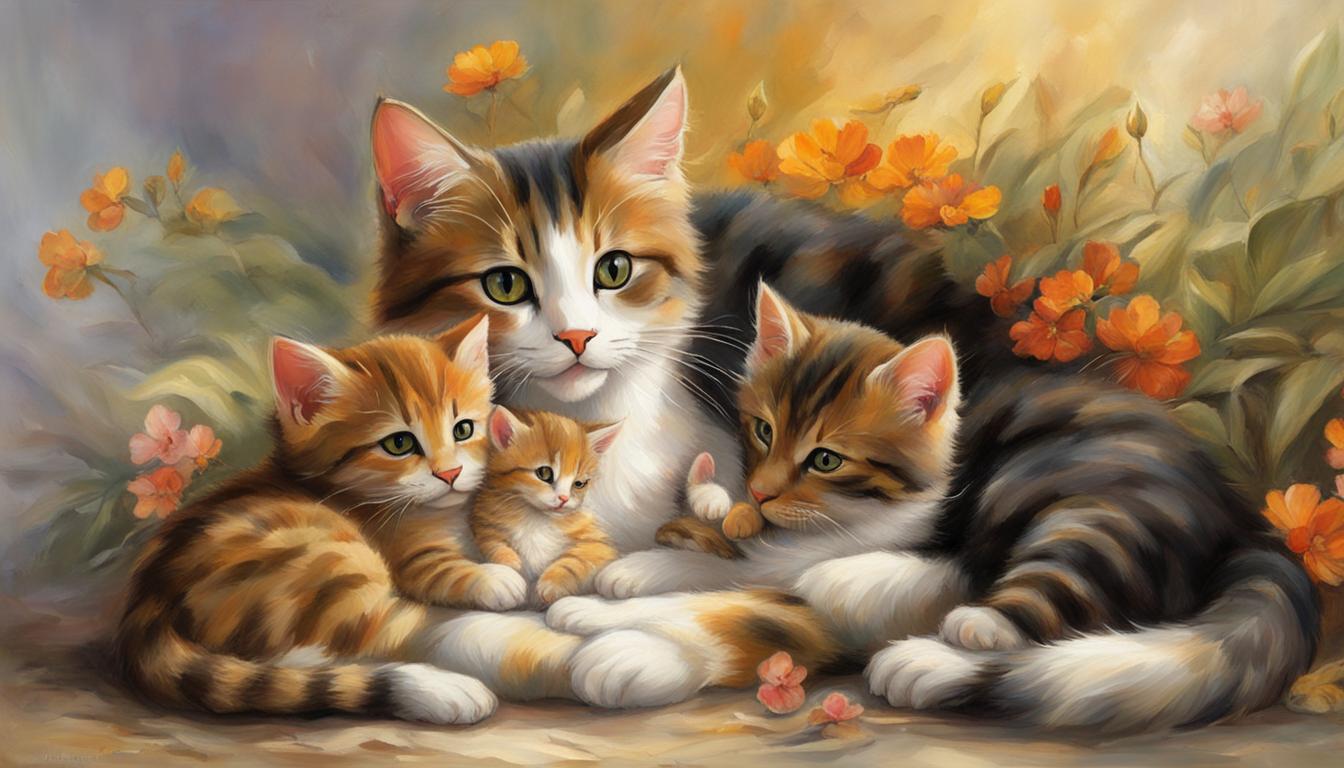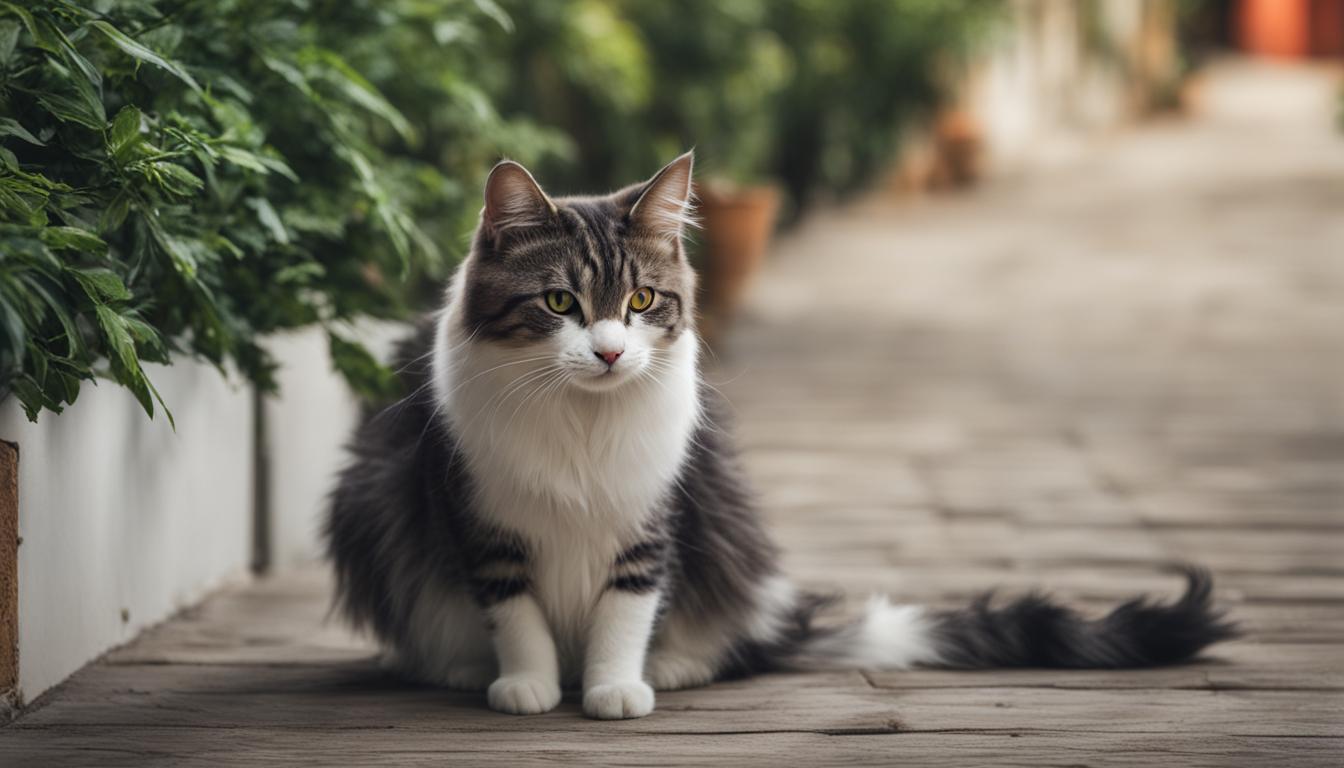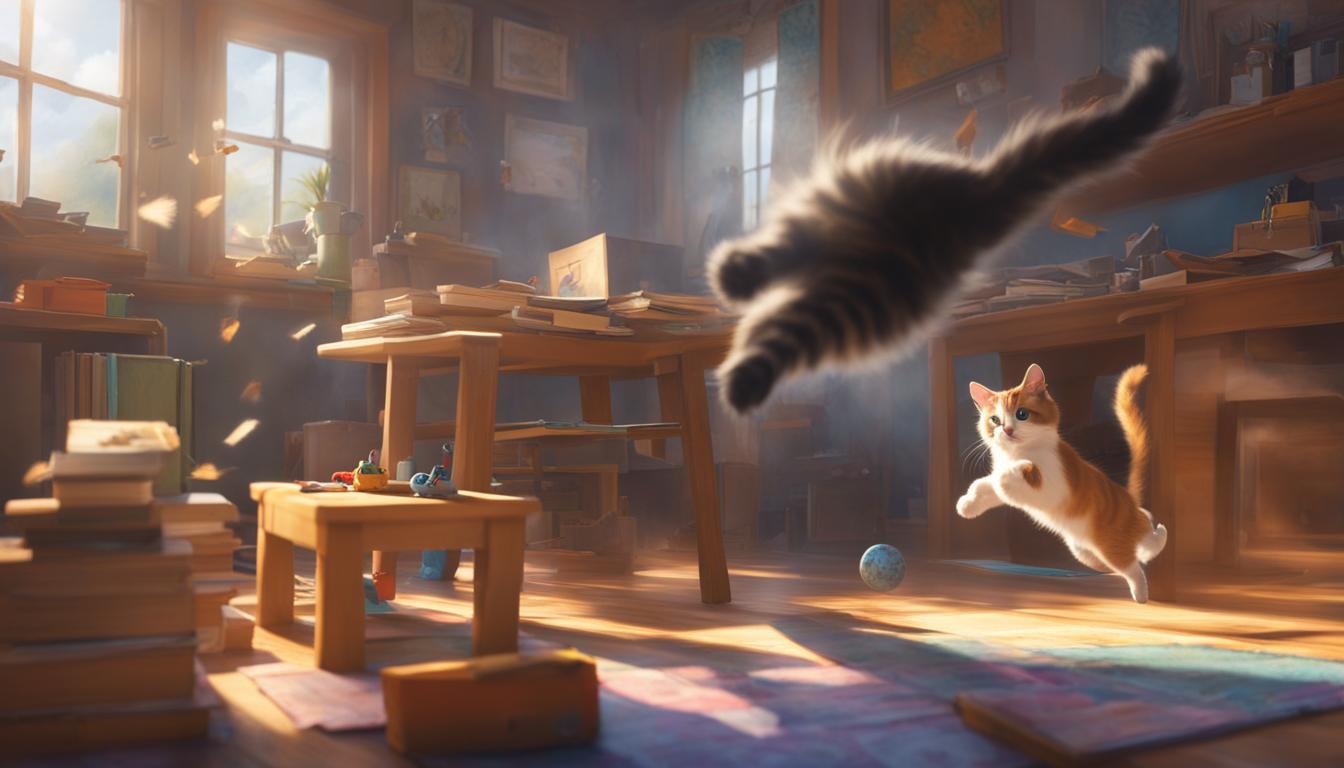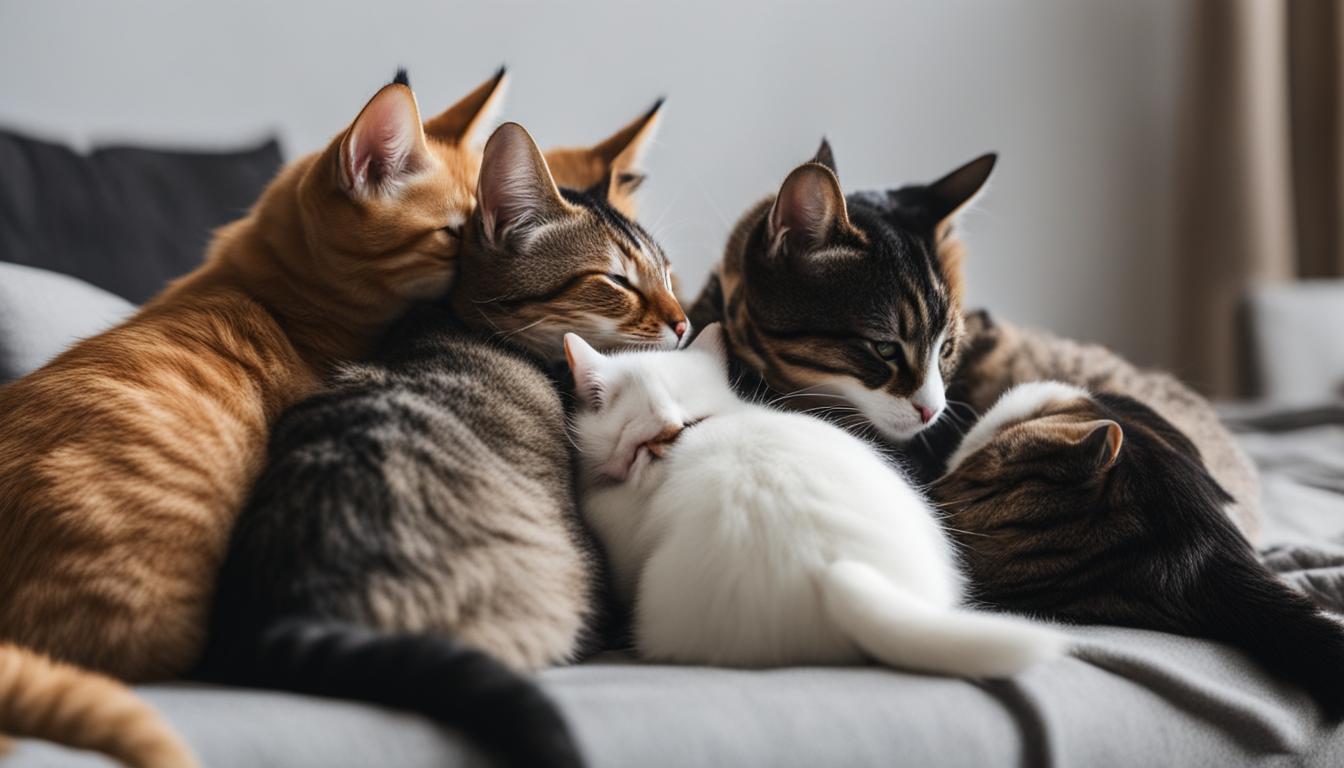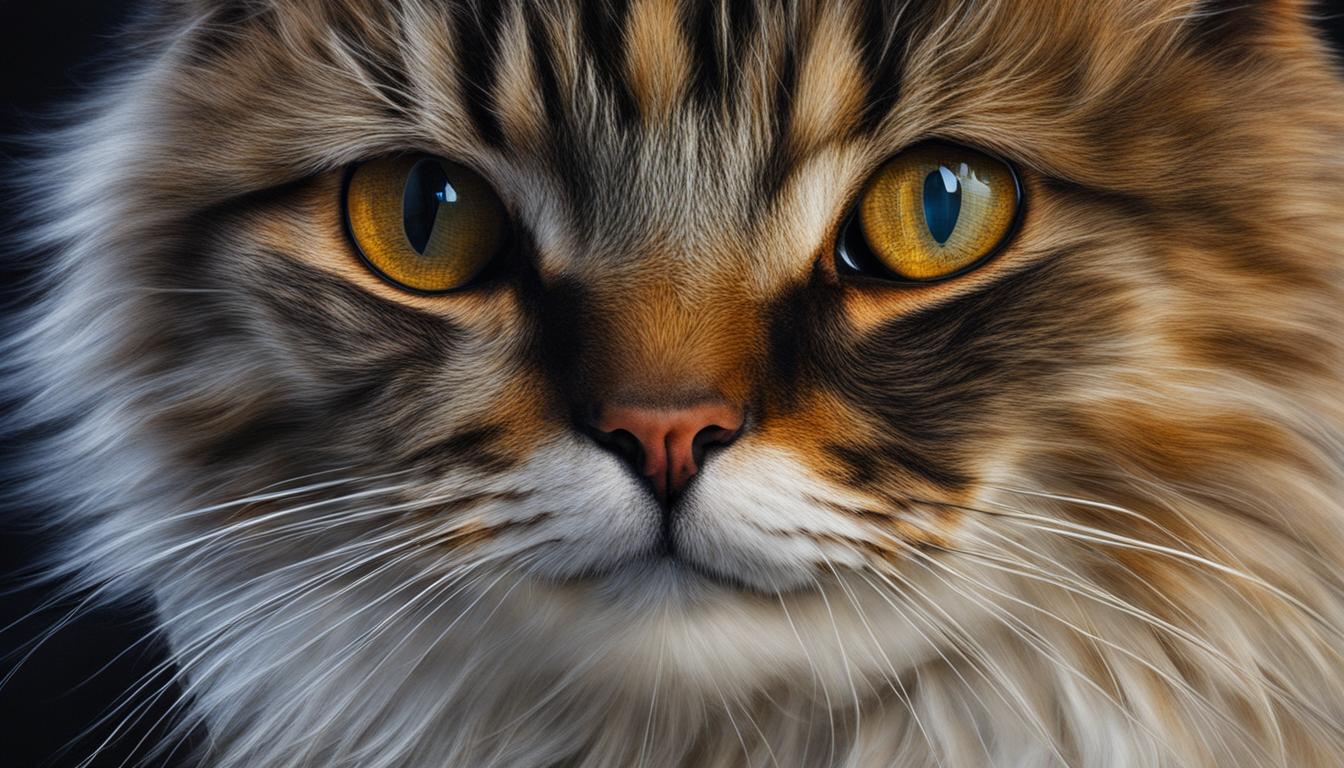As a passionate cat lover, I’ve always been fascinated by the profound bond between mother cats and their kittens. The way these feline queens instinctively care for their offspring is nothing short of remarkable. Join me on this journey as we delve into the intricate world of feline parenting behavior and uncover the secrets behind their nurturing ways.
The behavior of mother cats, or queens as they are fondly called, goes beyond mere instinct. They display an unwavering dedication to their kittens, going to great lengths to protect and provide for them. Even after being spayed, mother cats continue to exhibit high levels of care and protection towards their young ones.
So, what exactly are the behaviors that define feline parenting? Let’s explore the regular check-ins, meticulous grooming, and the pure excitement they show upon reuniting with their kittens after separation periods.
Key Takeaways:
- Feline maternal instincts are a powerful force that drives mother cats to care for their kittens.
- Spaying cats does not eliminate their parenting behaviors.
- Mother cats exhibit various nurturing behaviors, including checking on their kittens, grooming them, and showing excitement upon reuniting.
- Understanding feline parenting is crucial for the well-being and development of kittens.
- The bond between mother cats and kittens plays a vital role in the socialization and emotional growth of the young ones.
The Importance of Feline Maternal Instincts
When it comes to raising kittens, mother cats play a crucial role in their care and development. From the moment of birth, mother cats exhibit remarkable maternal instincts, taking on the responsibility of nurturing and guiding their offspring through the early stages of life.
One of the most significant aspects of maternal care is kitten nutrition. Mother cats provide essential nourishment through nursing, ensuring that their kittens receive the vital nutrients they need for healthy growth and development. Additionally, the act of nursing strengthens the bond between mother and kittens, fostering a sense of security and comfort for the young ones.
As the kittens grow, their mother continues to play a vital role in their development. She teaches them important life skills, such as grooming, using the litter box, and even hunting. By observing their mother’s behavior, kittens learn how to interact with their environment and develop the necessary skills to thrive on their own.
To ensure the well-being of mother cats and their kittens, it is essential to foster and support their maternal instincts. Creating a safe and comfortable environment for them to raise their young is crucial. Providing nutritious food, clean water, and a quiet space for the mother cat to nurse and care for her kittens can greatly contribute to their overall health and development.
The Stages of Kitten Development with a Mother Cat
Understanding the stages of kitten development with their mother can give valuable insights into their needs and behaviors. The following table outlines the key stages of development:
| Stage | Description |
|---|---|
| Newborn Stage | Kittens are completely dependent on their mother for nutrition and warmth. Their eyes and ears are closed, and they spend most of their time sleeping and nursing. |
| Transitional Stage | Kittens begin to open their eyes and ears. They start to explore their surroundings and gain mobility, although their movements may still be wobbly. |
| Socialization Stage | Kittens become more active and curious. They interact with their littermates and mother, learning important social skills and play behaviors. |
| Weaning Stage | Kittens start to eat solid food and gradually reduce their dependency on their mother’s milk. The mother cat also encourages weaning by grooming her kittens less frequently. |
| Independence Stage | Kittens become more independent and develop their own personalities. They spend less time with their mother and start exploring their surroundings on their own. |
By understanding the stages of kitten development, we can better support the mother cat in providing the necessary care and guidance for her kittens. It is essential to allow the mother cat to take the lead in nurturing and socializing her young, as this promotes healthy development and the formation of strong family bonds.
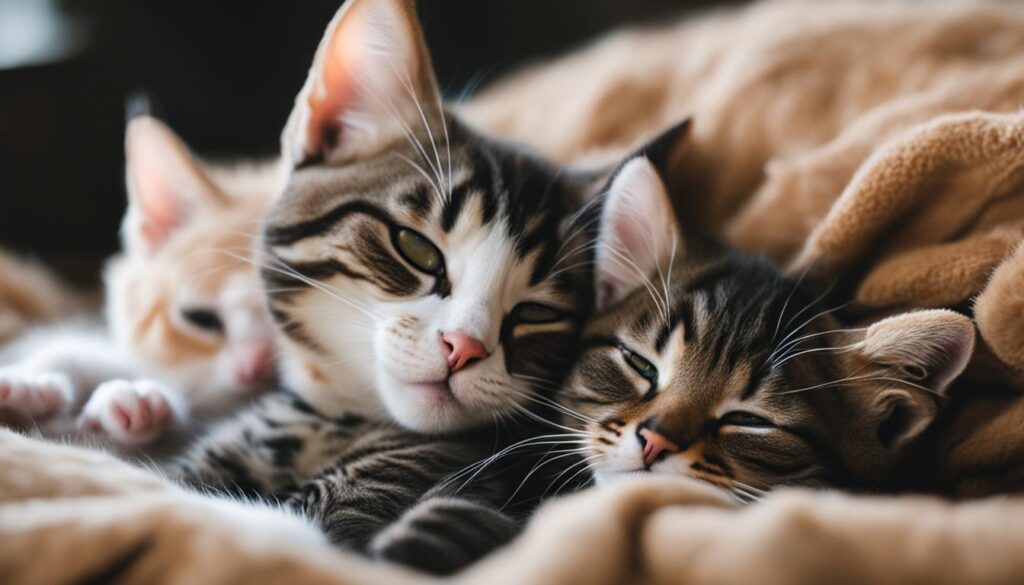
“A mother cat’s love and care are invaluable in shaping the lives of her kittens. From teaching them essential skills to providing comfort and nourishment, she plays a vital role in their early development.” – Anonymous
Bonding Between Mother Cats and Kittens
When it comes to the bond between mother cats and their kittens, nature truly shines. Mother cats exhibit remarkable surrogate mother behavior, nurturing their young ones with warmth, nourishment, and guidance. This bond between a mother cat and her kittens is crucial for their socialization and overall development. Understanding the intricate behaviors involved in this bond can provide valuable insights into the fascinating world of feline parenting.
Weaning behaviors in mother cats mark an important stage in the bonding process. As the kittens grow, the mother cat gradually introduces them to solid food and encourages their independence. This transition is essential for the kittens’ development, helping them learn vital skills and adapt to their environment. The mother cat’s patience and guidance during this period play a vital role in shaping the kittens’ future behaviors and abilities.
“The bond between a mother cat and her kittens is a beautiful example of nature’s instinctual care and nurturing. Observing their interactions can be both heartwarming and enlightening.”
Through observing the surrogate mother behavior in cats, we gain a deeper appreciation for the complexity of their social dynamics. The bond between a mother cat and her kittens extends beyond mere survival; it also serves as a foundation for strong familial connections and future relationships within the feline community. By studying these behaviors, we can gain a deeper understanding of the importance of maternal instincts in cats and their profound impact on the well-being of the entire feline family.
Table: Stages of Bonding Between Mother Cats and Kittens
| Stage | Description |
|---|---|
| Nurturing | Mother cat provides warmth, nourishment, and protection to her kittens. |
| Physical Interactions | Mother cat grooms her kittens, engaging in playful activities to strengthen their bond. |
| Weaning | Mother cat gradually introduces solid food, encouraging independence and self-reliance in the kittens. |
| Socialization | Kittens learn social skills from their mother, interacting with her and their littermates. |
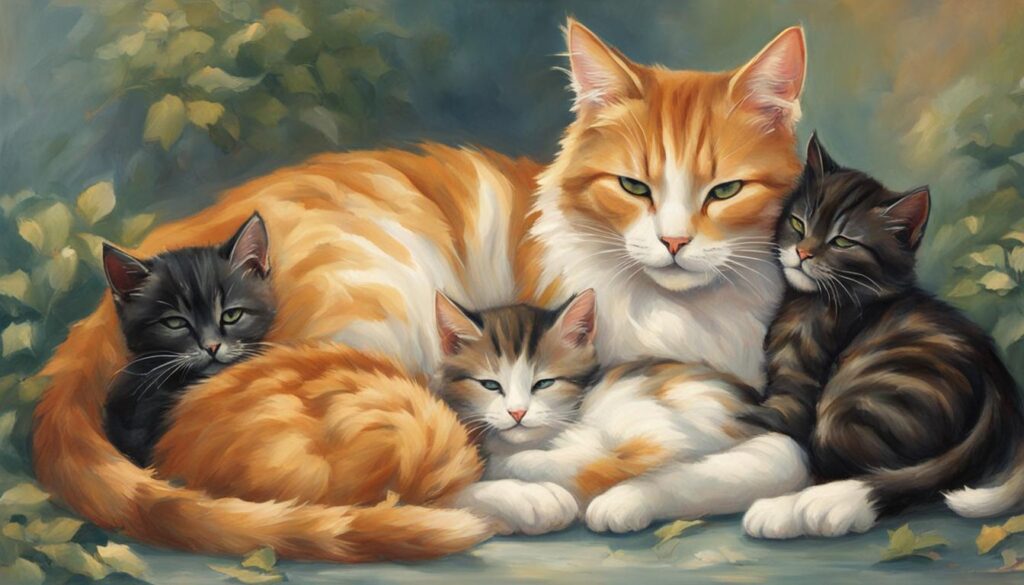
The bond between a mother cat and her kittens is a testament to the incredible instincts and care found in feline parenting. It is a relationship filled with tenderness, teaching, and lifelong connections. Through understanding and appreciating these intricate behaviors, we can deepen our admiration for the incredible world of cats.
Cat Adoption and Bonding with Kittens
When it comes to cat adoption and introducing a new kitten to a mother cat, a gradual and positive introduction process is key. It’s important to remember that the mother cat may initially exhibit negative behavior such as hissing or growling towards the new addition. However, with time and patience, the mother cat may ultimately accept and even adopt the new kitten as her own.
The bonding process between cats and kittens can take time and varies depending on individual personalities. It usually takes eight to twelve months for cats to form a close relationship. During this time, the mother cat plays a critical role in nurturing and guiding the kitten’s development.
Introducing a new animal should be done carefully to avoid aggression from the mother cat and potential harm to the kittens. It’s essential to provide a safe and comfortable environment for both the mother cat and the new kitten. Gradual interactions, supervised playtime, and ensuring that each cat has their own space can help facilitate a positive bond between them.
| Stages of Bonding Between Cats and Kittens | Mother Cat Behavior Towards Adopted Kittens |
|---|---|
| Suspicion and caution | The mother cat may display hissing and growling towards the new kitten, expressing suspicion and caution. |
| Tolerance and observation | The mother cat starts to tolerate the presence of the new kitten and observes their behavior from a distance. |
| Interaction and acceptance | The mother cat gradually interacts with the new kitten, engaging in play and grooming behaviors, showing signs of acceptance. |
| Bonding and nurturing | The mother cat fully accepts and adopts the new kitten as her own, providing nurturing care and guidance throughout their development. |
By understanding the stages of bonding between cats and kittens and being mindful of the mother cat’s behavior towards the new kitten, we can create a harmonious and loving environment for everyone involved. Building a strong bond ensures the well-being and happiness of the cats and promotes a positive relationship between them.
Cats and Humans: A Unique Bond
When it comes to the relationship between cats and humans, there is a special bond that goes beyond mere companionship. Cats often consider their human caregivers as parental figures, displaying behaviors that resemble those exhibited by mother cats. This unique bond is a testament to the deep connection and affection that cats can develop towards their human counterparts.
Cats, known for their independent nature, can surprise their owners with displays of affection. They may rub against their humans’ legs, purr contentedly in their presence, or even groom them with gentle licks. These behaviors mimic the nurturing acts displayed by mother cats towards their kittens. It’s as if cats see their humans as part of their family, relying on them for love, care, and protection.
“The bond between humans and their feline companions is truly extraordinary. Cats have a way of making us feel cherished and loved, just like the way a mother cat cares for her kittens. It’s a beautiful and heartwarming connection that brings joy and fulfillment to both parties involved.” – Cat Lover Magazine
Research has shown that cats can form strong attachments to their human caregivers, with some studies suggesting that they may even form a secure bond similar to the one between human infants and their parents. This bond not only provides emotional support and companionship but also contributes to the overall well-being and happiness of cats.
So, the next time your cat curls up beside you or gently nuzzles your hand, remember that they see you as more than just a human. To them, you are a beloved family member, a parental figure, and a source of comfort and affection.
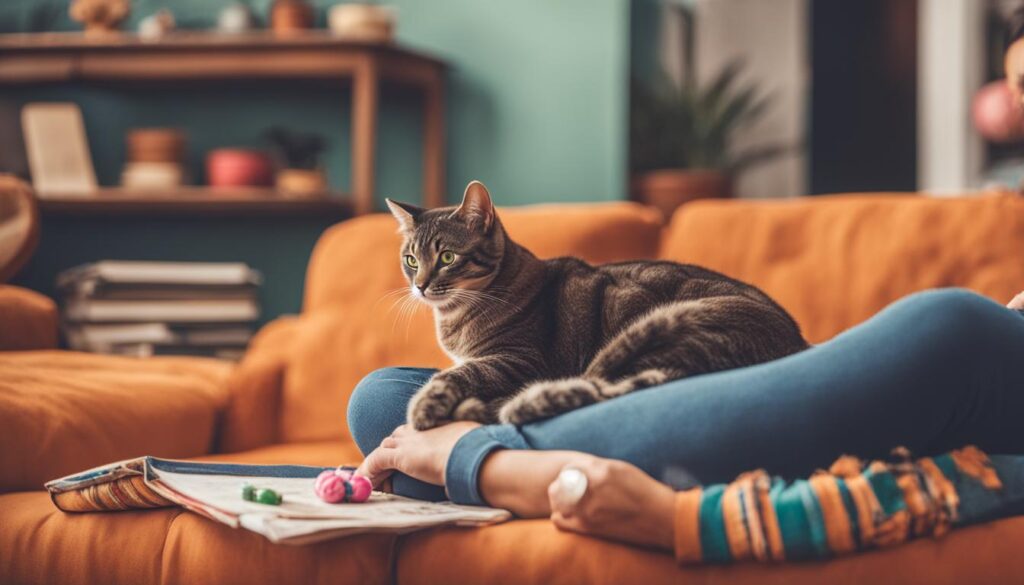
The Role of Cats in Biomedical Research
Cats have made unique contributions to the field of biomedical research through their genetic makeup and the study of feline diseases. Feline genomics, the study of the cat genome, provides valuable insights into human diseases and genetic variations. This research helps scientists understand the molecular mechanisms underlying various human conditions, such as cancer, immunodeficiency diseases, and infections.
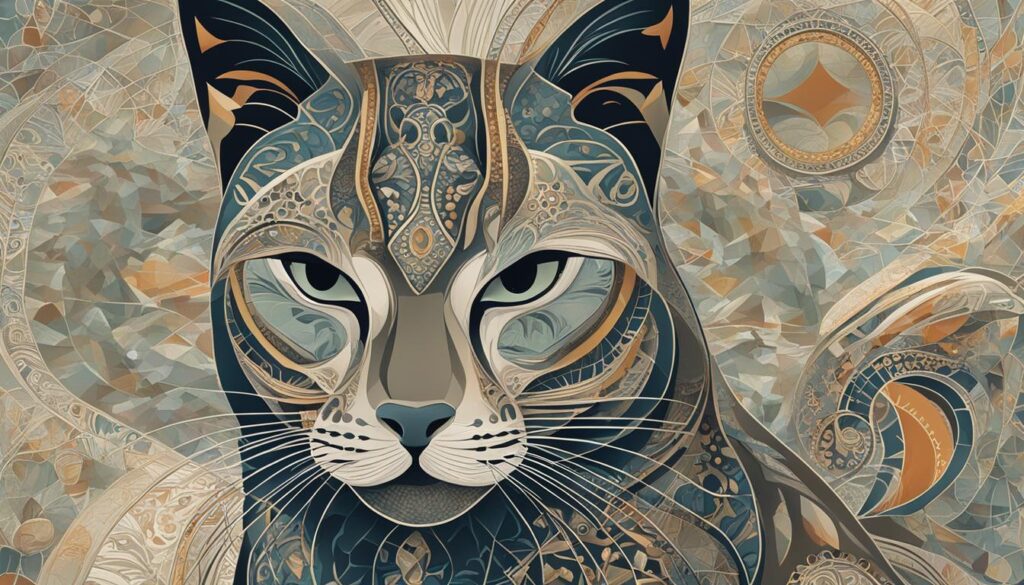
Inherited feline diseases serve as essential models for studying their human counterparts. These diseases often share similar genetic traits and manifest in comparable ways. By studying feline diseases like polycystic kidney disease, hypertrophic cardiomyopathy, and retinal degeneration, researchers can gain insights into the pathogenesis and potential treatment options for humans with similar conditions. Feline models also help evaluate the efficacy and safety of potential therapeutics.
Key Contributions of Cats in Biomedical Research:
- Feline genomics: Providing insights into human diseases and genetic variations.
- Inherited feline diseases as models for human diseases: Studying similar genetic traits and manifestations.
- Evaluation of therapeutics: Assessing the efficacy and safety of potential treatments.
“The study of feline genomics and inherited feline diseases has opened up exciting possibilities for advancing medical knowledge and developing potential therapies for human diseases.” – Dr. Emily Johnson, Research Scientist
Cats also serve as models for viral oncogenesis, such as feline leukemia virus disease, and immunodeficiency diseases like feline immunodeficiency virus. These models provide valuable insights into the understanding of human viral diseases and the development of vaccines and antiviral therapies. Furthermore, the study of Helicobacter felis infection in cats contributes to the understanding of human Helicobacter-related diseases, including stomach ulcers and gastric cancer.
| Unique Contributions of Cats to Biomedical Research | Examples |
|---|---|
| Feline Genomics | Insights into human diseases and genetic variations |
| Inherited Feline Diseases | Models for human diseases |
| Viral Oncogenesis | Understanding human viral diseases |
| Helicobacter felis Infection | Contributing to the study of human Helicobacter-related diseases |
Conclusion
In conclusion, feline maternal instincts and parenting behaviors are truly fascinating and showcase the incredible bond between mother cats and their kittens. These instincts drive mother cats to provide unwavering care, protection, and guidance to their offspring, ensuring their well-being and development.
Understanding and supporting these instincts is crucial for the overall health and happiness of both cats and their kittens. By recognizing the importance of maternal care and fostering a positive environment, we can contribute to the nurturing of strong bonds and the fostering of healthy development.
Furthermore, cats play a significant role in biomedical research, offering valuable insights into various human diseases. Their genetic makeup and unique characteristics provide researchers with invaluable models to study inherited diseases and investigate potential therapeutic approaches.
The special bond that cats share with humans is also noteworthy. Cats often consider their human caregivers as parental figures and exhibit behaviors that resemble mother-kitten interactions. Recognizing and nurturing these relationships can deepen the bond and enhance the well-being of both cats and humans.
FAQ
Do mother cats continue to care for their kittens after being spayed?
Yes, spaying cats does not eliminate their parenting instincts. Mother cats continue to show high levels of care and protection towards their kittens.
What behaviors do mother cats exhibit towards their kittens?
Mother cats regularly check on their offspring, groom them, and show excitement upon reuniting after separation periods.
How important are mother cats in the care and development of kittens?
Mother cats play a crucial role in providing essential nutrition through nursing and guiding their kittens through various stages of development. They are also crucial for the social and emotional development of the kittens.
How do mother cats bond with their kittens?
Mother cats act as surrogate mothers by providing warmth, nourishment, and guidance to their young ones. Through these nurturing behaviors, they form strong bonds with their kittens.
How long does it take for cats and kittens to form a close relationship?
It usually takes eight to twelve months for cats to form a close relationship with their kittens. The bonding process between cats and kittens varies depending on individual personalities.
Can cats consider humans as parental figures?
Yes, cats may consider their human caregivers as parental figures. They may display mother-kitten behaviors towards humans, showing affection and care.
What is the role of cats in biomedical research?
Cats play a significant role in biomedical research. Their unique genetic makeup, particularly in feline genomics, provides valuable insights into human diseases. They serve as models for studying various diseases such as feline leukemia virus, feline immunodeficiency virus, and Helicobacter felis infection.

